Nvidia GeForce GTX 670 in 2-Way and 3-Way SLI Configurations

Today we are going to discuss the performance of Nvidia’s multi-GPU configurations built with two and three overclocked GeForce GTX 670 graphics cards. Besides, we will also compare the performance of Nvidia GeForce HGTX 680 against AMD Radeon HD 7970 GHz Edition (emulated by overclocking) running the latest existing drivers.
Our previous review covered three proprietary GeForce GTX 670 graphics cards from Gigabyte, Palit and Zotac. Having collected so many graphics cards, including a reference GeForce GTX 670 too, we couldn’t help testing them in multi-GPU configurations. It is not often that we can build a 3-way SLI subsystem that may be expected to ensure a very high level of performance, at least theoretically. Besides that, we are going to compare a GeForce GTX 680 with a Radeon HD 7970 GHz Edition (simulated by overclocking a regular HD 7970) with the latest drivers from Nvidia and AMD. We’ve got some interesting results to share, so read on!
Testbed Configuration and Testing Methodology
So, here are our GeForce GTX 670s: a reference card from Nvidia, a Gigabyte GeForce GTX 670 Ultra Durable and a Zotac GeForce GTX 670 AMP! Edition.



Every card was tuned to the clock rates of the Zotac version, namely 1098/6608 MHz. The Gigabyte GTX 670 Ultra Durable went into the topmost PCI Express slot of our Intel Siler DX79SI mainboard. The reference card occupied the second slot and the bottom slot was given to the Zotac. The slots worked at x16+x8+x8 speed due to the mainboard’s limitations. As for our 2-way SLI configuration, it was built out of the Gigabyte in the first slot and the Zotac in the second, both slots working at their full speed (x16+x16).
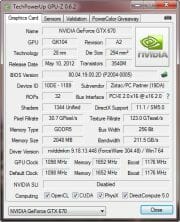
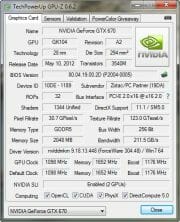
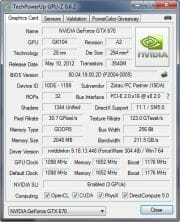
To carry out a comparative test of Nvidia GeForce GTX 680 vs. AMD Radeon HD 7970 GHz Edition, we took a Zotac GeForce GTX 680 2GB AMP! Edition (we’ll tell you more about this card in an upcoming review) and a Sapphire Radeon HD 7970 OC 3GB.
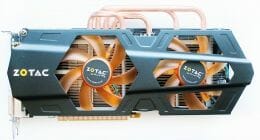
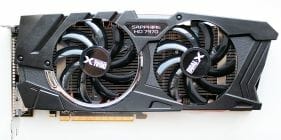
The former’s clock rates were reduced to those of the reference GeForce GTX 680, i.e. 1006/6008 MHz, whereas the latter was overclocked to the level of the AMD Radeon HD 7970 GHz Edition (1050/6000 MHz).
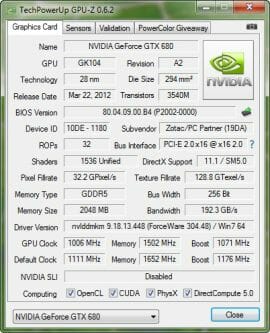
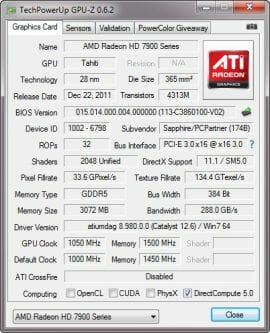
So, we’ll see how faster the new Radeon is and whether it can beat the fastest GeForce.
All participating graphics cards were tested in a system with the following configuration:
- Mainboard: Intel Siler DX79SI (Intel X79 Express, LGA 2011, BIOS 0494 from 04/24/2012);
- CPU: Intel Core i7-3960X Extreme Edition, 3.3 GHz, 1.2 V, 6 x 256 KB L2, 15 MB L3 (Sandy Bridge-E, C1, 32 nm);
- CPU cooler: Phanteks PH-TC14PE (2 x 135 mm fans at 900 RPM);
- Thermal interface: ARCTIC MX-4;
- System memory: DDR3 4 x 4GB Mushkin Redline (Spec: 2133 MHz / 9-11-10-28 / 1.65 V);
- Graphics cards:
- Nvidia GeForce GTX 670 2 GB, 256 bit, GDDR5, 1098/6608 MHz;
- Gigabyte GeForce GTX 670 Ultra Durable 2 GB, 256 bit, GDDR5, 1098/6608 MHz;
- Zotac GeForce GTX 670 AMP! Edition 2 GB, 256 bit, GDDR5, 1098/6608 MHz;
- Zotac GeForce GTX 680 AMP! Edition 2 GB, 256 bit, GDDR5, 1006/6008 MHz;
- Sapphire Radeon HD 7970 OC 3 GB, 384 bit, GDDR5, 1050/6000 MHz;
- System drive: Crucial m4 256 GB SSD (SATA-III,CT256M4SSD2, BIOS v0009);
- Drive for programs and games: Western Digital VelociRaptor (300GB, SATA-II, 10000 RPM, 16MB cache, NCQ) inside Scythe Quiet Drive 3.5” HDD silencer and cooler;
- Backup drive: Samsung Ecogreen F4 HD204UI (SATA-II, 2 TB, 5400 RPM, 32 MB, NCQ);
- System case: Antec Twelve Hundred (front panel: three Noiseblocker NB-Multiframe S-Series MF12-S2 fans at 1020 RPM; back panel: two Noiseblocker NB-BlackSilentPRO PL-1 fans at 1020 RPM; top panel: standard 200 mm fan at 400 RPM);
- Control and monitoring panel: Zalman ZM-MFC3;
- Power supply: Xigmatek “No Rules Power” NRP-HC1501 1500 W (with a default 140 mm fan);
- Monitor: 27” Samsung S27A850D.
In order to lower the dependence of the graphics cards performance on the overall platform speed, I overclocked our 32 nm six-core CPU with the multiplier set at 37x, BCLK frequency set at 125 MHz and “Load-Line Calibration” enabled to 4.625 GHz. The processor Vcore was increased to 1.46 V in the mainboard BIOS:
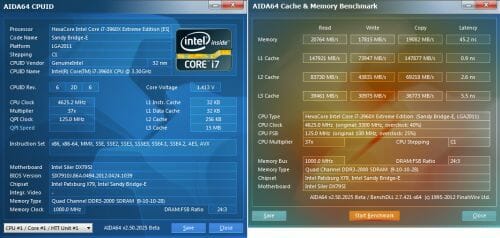
Hyper-Threading technology was enabled. 16 GB of system DDR3 memory worked at 2 GHz frequency with 9-10-10-28 timings and 1.65V voltage.
The test session started on June 22, 2012. All tests were performed in Microsoft Windows 7 Ultimate x64 SP1 with all critical updates as of that date and the following drivers:
- Intel Chipset Drivers 9.3.0.1020 WHQL from 01/26/2011 for the mainboard chipset;
- DirectX End-User Runtimes libraries from November 30, 2010;
- AMD Catalyst 12.6 beta driver from 05/31/2012 + Catalyst Application Profiles 12.6 (CAP1) for AMD based graphics cards;
- Nvidia GeForce 304.48 beta driver for Nvidia based graphics cards.
The latest Catalyst drivers didn’t boost the performance of the Radeon HD 79xx graphics cards that much, which was definitely not the case with the new GeForce driver version 304.38. Except for two-three applications from the list of utilized benchmarks, the performance in all other tests improved stably by 2~3%, and in Crysis 2, Batman: Arkham City and all synthetic tests the improvement was as high as 5% or more in individual test modes and test resolutions. On top of that they also fixed the bug in Total War: Shogun 2 game, so that all GeForce GTX 6xx cards now run much better (up to +60%) in this game. So, it would be fair to day that Nvidia is well prepared to welcome the new AMD Radeon HD 7970 GHz edition properly.
The graphics cards were tested in two resolutions: 1920×1080 and 2560×1440. The tests were performed in two image quality modes: “Quality+AF16x” – default texturing quality in the drivers with enabled 16x anisotropic filtering and “Quality+ AF16x+MSAA 4(8)x” with enabled 16x anisotropic filtering and full screen 4x or 8x antialiasing if the average framerate was high enough for comfortable gaming experience. We enabled anisotropic filtering and full-screen anti-aliasing from the game settings. If the corresponding options were missing, we changed these settings in the Control Panels of Catalyst and GeForce drivers. We also disabled Vsync there. There were no other changes in the driver settings.
The list of games and applications used in this test session includes two popular semi-synthetic benchmarking suites, one technical demo and 15 games of various genres:
- 3DMark Vantage (DirectX 10) – version 1.0.2.1, Performance and Extreme profiles (only basic tests);
- 3DMark 2011 (DirectX 11) – version 1.0.3.0, Performance and Extreme profiles;
- Unigine Heaven Demo (DirectX 11) – version 3.0, maximum graphics quality settings, tessellation at “extreme”, AF16x, 1280×1024 resolution with MSAA and 1920×1080 with MSAA 8x;
- S.T.A.L.K.E.R.: Call of Pripyat (DirectX 11) – version 1.6.02, Enhanced Dynamic DX11 Lighting profile with all parameters manually set at their maximums, we used our custom cop03 demo on the Backwater map;
- Left 4 Dead 2 (DirectX 9) – version 2.1.0.4, maximum graphics quality settings, proprietary d98 demo (two runs) on “Death Toll” map of the “Church” level;
- Metro 2033: The Last Refuge (DirectX 10/11) – version 1.2, maximum graphics quality settings, official benchmark, “High” image quality settings; tesselation, DOF and MSAA4x disabled; AAA aliasing enabled, two consecutive runs of the “Frontline” scene;
- Just Cause 2 (DirectX 11) – version 1.0.0.2, maximum quality settings, Background Blur and GPU Water Simulation disabled, two consecutive runs of the “Dark Tower” demo;
- Aliens vs. Predator (2010) (DirectX 11) – Texture Quality “Very High”, Shadow Quality “High”, SSAO On, two test runs in each resolution;
- Lost Planet 2 (DirectX 11) – version 1.0, maximum graphics quality settings, motion blur enabled, performance test “B” (average in all three scenes);
- StarCraft 2: Wings of Liberty (DirectX 9) – version 1.4.3, all image quality settings at “Extreme”, Physics at “Ultra”, reflections On, two 2-minute runs of our own “bench2” demo;
- Sid Meier’s Civilization V (DirectX 11) – version 1.0.1.348, maximum graphics quality settings, two runs of the “diplomatic” benchmark including five heaviest scenes;
- Tom Clancy’s H.A.W.X. 2 (DirectX 11) – version 1.04, maximum graphics quality settings, shadows On, tessellation Off (not available on Radeon), two runs of the test scene;
- Total War: Shogun 2 (DirectX 11) – version 2.0, built in benchmark (Sekigahara battle) at maximum graphics quality settings;
- Crysis 2 (DirectX 11) – version 1.9, we used Adrenaline Crysis 2 Benchmark Tool v.1.0.1.13. BETA with “Ultra High” graphics quality profile and activated HD textures, two runs of a demo recorded on “Times Square” level;
- Hard Reset Demo (DirectX 9) – benchmark built into the demo version with Ultra image quality settings, one test run;
- Batman: Arkham City (DirectX 11) – version 1.2, maximum graphics quality settings, physics disabled, two sequential runs of the benchmark built into the game.
- Battlefield 3 (DirectX 11) – version 1.4, all image quality settings set to “Ultra”, two successive runs of a scripted scene from the beginning of the “Going Hunting” mission 110 seconds long;
- DiRT Showdown (DirectX 11) – version 1.0, built-in benchmark at maximum graphics quality settings (“Ultra” preset) on the “Nevada” track.
If the game allowed recording the minimal fps readings, they were also added to the charts. We ran each game test or benchmark twice and took the best result for the diagrams, but only if the difference between them didn’t exceed 1%. If it did exceed 1%, we ran the tests at least one more time to achieve repeatability of results.
Performance
3DMark Vantage
3DMark Vantage isn’t a heavy test for today’s top-end graphics cards, let alone multi-GPU configurations, so we should only focus on the Extreme settings. The 2-way SLI built out of GeForce GTX 670s is highly efficient then, delivering an 80% performance boost. The 3-way SLI can only add 23% more. This cannot be explained by the platform’s limitations because the Performance scores are higher. Thus, 3-way SLI technology is just not as efficient as it should be.
The Nvidia GeForce GTX 680 comes out the winner in its race against the accelerated Radeon HD 7970. It has no rivals in 3DMark Vantage as yet. The Zotac GeForce GTX 670 AMP! Edition (1098/6608 MHz) is very close to the reference GeForce GTX 680, but can’t overtake it.
3DMark 2011
Nvidia’s multi-GPU technology does better in 3DMark 2011 where the 2-way SLI configuration is up to 96% faster than the single card and the 3-way SLI adds 36% more. Of course, the latter number may not seem high enough to justify the addition of a third graphics card, yet the confident performance of our three GTX 670s must be noted anyway.
The Nvidia GeForce GTX 680 is again ahead of the AMD Radeon HD 7970 GHz Edition. The Zotac GeForce GTX 670 AMP! Edition stops 4% short of the leader’s result.
Unigine Heaven Demo
The GeForce GTX 670-based multi-GPU configurations look good in this test, too. At the lower-quality settings the second card adds 44% and the third card adds 49% more to the single card’s result. And at the higher resolution with 8x antialiasing they add 88% and 33%, respectively.
There are no changes in the standings of the Nvidia GeForce GTX 680, AMD Radeon HD 7970 GHz Edition and Zotac GeForce GTX 670 AMP! Edition except that they all deliver the same results at the highest settings.
S.T.A.L.K.E.R.: Call of Pripyat
The first game on our list makes it clear that the third card in our SLI configuration isn’t worth the trouble of buying and installing. While the 2-way GeForce GTX 670 SLI can increase the frame rate by 68 to 96% compared to the single GTX 670, the 3-way SLI is a mere 19-23% ahead of the tandem. The three GTX 670s are even slower than the two at the lowest settings, which must be due to the lower graphics subsystem load and higher overhead associated with 3-way SLI.
As opposed to the three semi-synthetic benchmarks, the AMD Radeon HD 7970 GHz Edition scores a win over the Nvidia GeForce GTX 680 when it comes to actual games. The gap is just a few frames per second, though. The Zotac GeForce GTX 670 AMP! Edition is somewhere in between the reference GTX 670 and 680 in performance.
Left 4 Dead 2
The top-end graphics hardware we’ve got today can only be compared in Left 4 Dead 2 at 2560×1440 with anisotropic filtering and 8x antialiasing. At such settings, the two GeForce GTX 670s are 79% ahead of the single card whereas the third GTX 670 adds only 12% to that. So again, the third card’s resources seem to be wasted.
Metro 2033: The Last Refuge
The two multi-GPU configurations boast exemplary scalability in Metro 2033: The Last Refuge: up to 73% in 2-way SLI and up to 93% in 3-way SLI mode. Running ahead, we can tell you that these are the best results the 3-way SLI configuration could achieve in our tests. That said, we have to draw your attention to the low bottom speed which doesn’t grow up along with the average frame rate, so playability is questionable even on the multi-GPU configurations.
The NVIDIA GeForce GTX 680 falls behind the AMD Radeon HD 7970 GHz Edition and is also somewhat slower than the pre-overclocked Zotac GeForce GTX 670 AMP! Edition.
Just Cause 2
Just Cause 2 is one more game that can be used to showcase the benefits of Nvidia’s SLI technology, even though at high-quality and resource-consuming settings only. For example, the third card adds 8-26% to the 2-way configuration’s speed at 1920×1080 without antialiasing but the numbers grow up to 33-50% when we switch to 2560×1440. So, SLI works well and the game is playable with comfort on the 2- and 3-way SLI setups.
The Nvidia GeForce GTX 680 is equal to the AMD Radeon HD 7970 GHz Edition here, so AMD seems to have caught up with its archrival by releasing the accelerated HD 7970 model. We can also note that the pre-overclocked GTX 670 from Zotac is just as fast as the two mentioned flagship cards.
Aliens vs. Predator (2010)
The multi-GPU configurations are both good in Aliens vs. Predator (2010) except for the resolution of 2560×1440 pixels with 4x antialiasing. The game is known to need over 1.5 gigabytes of graphics memory at such settings and, even though the GeForce GTX 670 comes with 2 gigabytes on board, it may lack memory to show its best in a SLI setup. That’s the only explanation we can find for the low results.
The Nvidia GeForce GTX 680 is inferior to the AMD Radeon HD 7970 GHz Edition in this game, but this might have been expected since the GTX 680 was slower than the original version of the HD 7970 card, too. The Zotac GeForce GTX 670 AMP! Edition is just as fast as the GeForce GTX 680, again.
Lost Planet 2
The efficiency of Nvidia’s SLI technology depends on the graphics load in this test. The second and third graphics cards provide more benefits at higher settings. On the other hand, there is no real point in building a SLI configuration to play Lost Planet 2 because this game runs perfectly well even on a single GeForce GTX 670.
The AMD Radeon HD 7970 GHz Edition is closer to the GTX 680 than the original HD 7970, yet cannot overtake it. The pre-overclocked GTX 670 from Zotac is in between the reference GTX 670 and GTX 680.
StarCraft II: Wings of Liberty
As you can see in the diagram, this game isn’t compatible with SLI technology, just as it’s not compatible with the Radeons when antialiasing is turned on.
Sid Meier’s Civilization V
The 2-way SLI configuration is 86 to 105% ahead of the single card in Sid Meier’s Civilization V, which is a record-breaking result in this test session. The third card isn’t that useful because the 3-way SLI configuration can only add 20-30% to the frame rate.
The AMD Radeon HD 7970 GHz Edition is ahead of both the GeForce GTX 680 and the pre-overclocked card from Zotac.
Tom Clancy’s H.A.W.X. 2
The third GeForce GTX 670 is even harmful in Tom Clancy’s H.A.W.X. 2 because it lowers the frame rate rather than increases it. As opposed to it, the 2-way SLI is 69-92% ahead of the single GTX 670.
The high clock rates help the Radeon HD 7970 GHz Edition to catch up with the GeForce GTX 680. The Zotac is just as fast as the two flagship models.
Total War: Shogun 2
As opposed to the 2-way SLI configuration whose efficiency is as high as 80-92%, the 3-way SLI setup can only add 16-32% to the frame rate. The good news is that the bottom speed improves along with the average frame rate.
The new GeForce driver makes the GeForce GTX 6xx series fast in this game, the Radeon HD 7970 GHz Edition having a hard time challenging the leader. The Zotac GeForce GTX 670 AMP! Edition is once again competitive against the more expensive GeForce GTX 680.
Crysis 2
The 1920×1080 results in Crysis 2 resemble Tom Clancy’s H.A.W.X. 2 where the 2-way SLI configuration worked well but the third card only spoiled the picture. It is only at 2560×1400 that the 3-way SLI setup does better, outperforming the 2-way one by 26-29%. The scalability isn’t perfect, though, and there are also problems with the bottom speed.
There is no winner in the competition of the world’s fastest single-GPU graphic cards. The Nvidia GeForce GTX 680 and AMD Radeon HD 7970 GHz Edition are also rivaled by the Zotac GeForce GTX 670 AMP! Edition in this test.
Hard Reset Demo
This test doesn’t tell us anything new.
Batman: Arkham City
The multi-GPU configurations feel better in this game. Although there are still problems with the bottom speed, the average frame rate grows by 75-98% with the 2-way SLI and by 14-44% with the 3-way SLI configuration.
There’s no clear winner between the Nvidia GeForce GTX 680 and the AMD Radeon HD 7970 GHz Edition. The Nvidia is ahead when antialiasing is off, but the AMD is faster with antialiasing turned on.
Battlefield 3
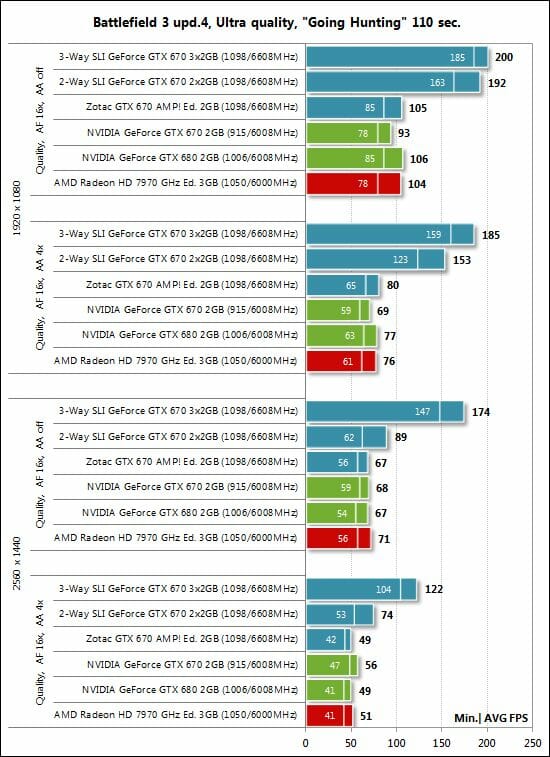
The Battlefield 3 results are inconsistent. The 2- and 3-way SLI configurations take turns delivering the higher performance boost depending on the graphics quality settings. The bottom speed is high, which is rather an exception from the general course of things we’ve seen throughout this test session.
The Nvidia GeForce GTX 680 is exactly as fast as the AMD Radeon HD 7970 GHz Edition in this game.
DiRT Showdown
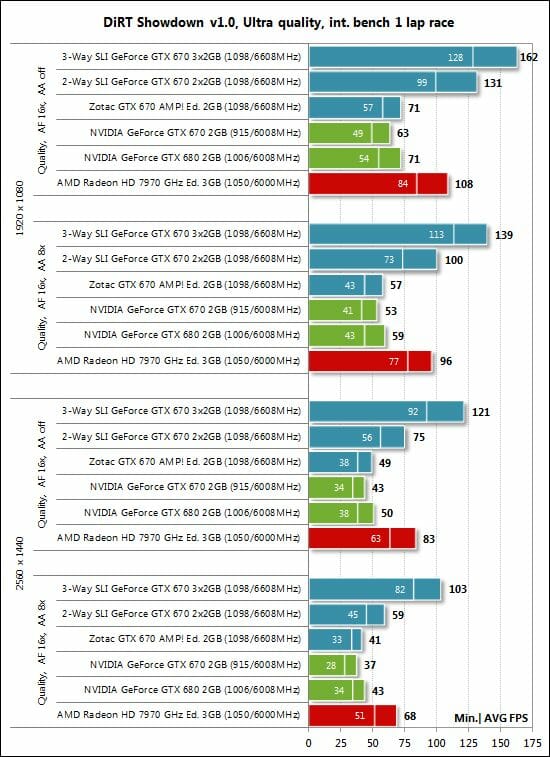
DiRT Showdown is one of the few games in this test session where both the 2-way and 3-way SLI configurations deliver satisfactory results. The former provides a performance boost of 44 to 86% and the latter, 24 to 75%. The AMD Radeon HD 7970 GHz Edition enjoys a huge advantage over the Nvidia GeForce GTX 680, the latter being no faster than the Zotac GeForce GTX 670 AMP! Edition.
Performance Summary Diagrams
First, let’s evaluate the efficiency of SLI technology with two overclocked GeForce GTX 670s.
Well, the two cards are much faster than the single one, especially in heavy applications and with enabled antialiasing, the performance benefits amounting to an average 69-71%. Sid Meier’s Civilization V, Crysis 2, Total War: Shogun 2 and S.T.A.L.K.E.R.: Call of Pripyat are the games where we can observe the highest SLI efficiency – over 90%!
When a third card is added to the SLI tandem, the picture becomes more complicated.
3-way SLI technology is quite efficient in Metro 2033: The Last Refuge, Battlefield 3, DiRT Showdown, and in the heavier test modes of Aliens vs. Predator (2010) and Just Cause 2. However, even in these games the average performance growth is generally below 50%. In most other tests the 3-way SLI is only 20-25% ahead of the 2-way SLI configuration. The third graphics card even lowers the frame rate in the easier test modes of Tom Clancy’s H.A.W.X. 2 and Crysis 2.
Now let’s compare the Zotac GeForce GTX 670 AMP! Edition and the Nvidia GeForce GTX 680.As you can see, these graphics cards are very close to each other. The Zotac is an average 1 to 1.5% slower without antialiasing and 1 to 2.5% faster with antialiasing (thanks to faster memory) across all the tests.
We guess it’s also interesting to compare the two fastest single-GPU solutions available today: Nvidia GeForce GTX 680 and AMD Radeon HD 7970 GHz Edition. The latter being a new model, it serves as a baseline here.
We wouldn’t say that AMD is definitely on the winning side with the updated Radeon HD 7970. Everything still depends on the specific game and driver optimizations. For example, the GeForce GTX 680 is ahead in Lost Planet 2, Tom Clancy’s H.A.W.X. 2, Hard Reset and the higher-quality mode of StarCraft II: Wings of Liberty whereas the AMD Radeon HD 7970 GHz Edition wins in S.T.A.L.K.E.R.: Call of Pripyat, Left 4 Dead 2, Metro 2033: The Last Refuge, Aliens vs. Predator (2010), Sid Meier’s Civilization V and DiRT Showdown. Well, that’s not the last of our Radeon HD 7970 GHz Edition tests as we are going to write a review of its reference sample soon.
Power Consumption
We measured the power consumption of computer systems with different graphics cards using a multifunctional panel Zalman ZM-MFC3 which can report how much power a computer (the monitor not included) draws from a wall socket. There were two test modes: 2D (editing documents in Microsoft Word and web surfing) and 3D (the benchmark from Metro 2033: The Last Refuge at 2560×1440 with maximum settings). Here are the results.
As opposed to the performance tests, the power consumption of the systems with one, two and three GeForce GTX 670s increases linearly, in steps of 175 watts. This is roughly equal to the specified power draw of the GTX 670 (170 watts). You’ll need an 850-watt or higher PSU for a configuration with an overclocked six-core CPU and three overclocked GeForce GTX 670s.
We can also note that the single GeForce GTX 670 and GTX 680 consume 20 watts less with the new driver (compared to our previous tests on the same testbed), just as promised by Nvidia. Thus, the system with a single GeForce GTX 680 needs 100 watts less at high load than the system with an AMD Radeon HD 7970 GHz Edition. We are yet to test an actual HD 7970 GHz Edition, so these are not final results.
Conclusion
Our tests of SLI configurations built out of overclocked GeForce GTX 670s suggest that a 2-way tandem can significantly boost performance in most games, especially in heavy ones and at high resolutions. A 3-way SLI is a different story because the third card doesn’t provide significant performance benefits, except for a couple of games, whereas this trio has more problems with the bottom speed than the tandem. We can blame a lot of factors for that. We used graphics cards from different brands, our mainboard doesn’t support three PCIe 3.0 slots at x16 speed (but there are actually no such LGA2011 mainboards at all), our platform may not have been fast enough to match the 3-way SLI configuration, or the GeForce driver may be not yet polished off.
That said, we guess multi-GPU configurations are just prone to have such problems. It’s not easy to make them show their theoretical best as there are too many factors to take care of when building them. And we haven’t even mentioned the high noise and cooling-related problems unavoidable with three GeForce GTX 670s. So, graphics subsystems with three or more graphics cards are largely meant for testers who want to set new performance records. For ordinary gamers who want maximum performance regardless of its cost, we’d recommend one or two GeForce GTX 690s. We had only one problem with the GTX 690s in SLI mode – our platform was too slow to keep up. We’ll discuss this topic in more detail in an upcoming review, though.
We also want to add a few words about the results of the Zotac GeForce GTX 670 2GB AMP! Edition. Thanks to its factory overclocking, this card is as fast as the top-end GeForce GTX 680 although costs about 20% less. Coupled with the GTX 680 PCB, efficient cooler and extended 5-year warranty, the Zotac GeForce GTX 670 AMP! Edition seems to be one of the most attractive GTX 670s available today. It is going to be a perfect choice if you’re shopping for a GTX 670 right now.
And as a final remark, we don’t think that today’s competition between the Nvidia GeForce GTX 680 and the new AMD Radeon HD 7970 GHz Edition is conclusive. We’ll test them again with the newest drivers when we get a reference sample of the AMD card.